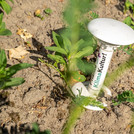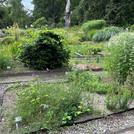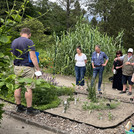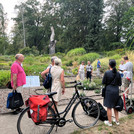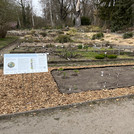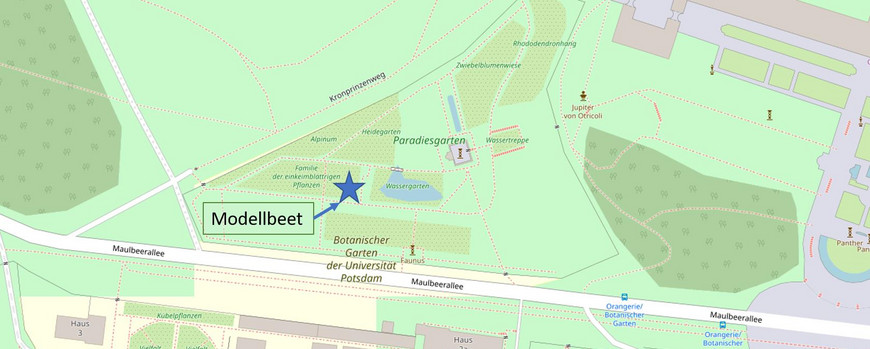Pflanze KlimaKultur!: Assessing Climate influence on urban Plant diversity with citizen scientists
Within the Citizen Science Project Pflanze KlimaKultur! (“Plant Climate Culture!”) the phenology of herbaceous plants has been monitored to research the influence of climate change on the seasonal development stages (phenology) in private and public gardens. The aim was to understand how climate changes affect the growth phases of plants.
Pflanze KlimaKultur! started in Spring 2022 under coordination of the botanical gardens of Jena, Halle, Leipzig (Deutsches Zentrum für integrative Biodiversitätsforschung-IDiv) and Berlin.
The volunteer citizen scientists received 11 herbaceous plant species with the same genetic origin, which they planted in a bed in their private garden according to instructions. From April 2022 to April 2024 they observed their phenology, i.e. budding, flowering, fruiting and aging, the so-called senescence. In addition, environmental parameters such as air and soil temperature were recorded.
Since the beginning of the project also the Botanical Garden of Potsdam houses one of the model bed with these selected plants. Several times a year there was the opportunity for the citizen scientists to ask questions about their own observations, exchange experiences and the possibility to pick up model plants. A total of 200 citizen scientists, including 15 in the Potsdam area, were involved.
The project ended in April 2024. The final event of the project “Plant Climate Culture!” took place at the Botanical Garden in Berlin. More than 100 citizen scientists and researchers came together to celebrate the successful completion of the project and to discuss initial results. For example, wild tulips (Tulipa sylvestris) were found to start their flowering period one week earlier when the air temperature was increased by one degree Celsius. Moreover, the cooling effect of green spaces was also observable in plant phenology, reaffirming their important role for climate resilience. The evaluations continue.
But what happens now in the Potsdam Botanical Garden after the project came to a close? The model bed will remain in place, continue to invite visitors and will be further monitored weekly, with data contributed to the PhenObs research project. The monitoring project is also part of the open-air exhibition on climate change in the Sanssouci Cultural Heritage Park "Re:Generation", which can be visited from 27 April to 31 October 2024.
The Research plants are:
Althaea officinalis Echter Eibisch | Marsh mallow
Clematis recta Aufrechte Waldrebe | Erect clematis
Eranthis hyemalis Winterling | Winter aconite
Filipendula vulgaris Kleines Mädesüß | Dropwort
Malva sylvestris Wilde Malve | Common mallow
Salvia nemorosa Steppen-Salbei | Woodland sage
Saponaria officinalis Gewöhnl. Seifenkraut | Common soapwort
Scabiosa canescens Duft-Skabiose | Grey scabious
Securigera varia Bunte Kronwicke | Purple crown vetch
Solidago virgaurea Gewöhnliche Goldrute | European goldenrod
Tulipa sylvestris Wilde Tulpe | Wild tulip
Please have a look on the official website for [more details]
Mission
Urban habitats have long since become "hot spots" of biodiversity and climate change. Temperature and precipitation extremes have a greater impact in the city than in the countryside. Its pronounced temperature gradient makes it the ideal place to research the consequences of climate change.
Plants are particularly sensitive indicators of climate change. They quickly reflect possible ecological effects of climate change. The date of entry into certain phases of the seasonal life cycles of plants (phenology) is significantly influenced by temperature. Climate changes can thus be easily read from changes in the temporal developmental stages of plants.
Research questions are:
- When do the plants sprout, when do their leaves unfold, when do they flower, when do their fruits ripen, when do their leaves fall?
- How does climate change affect the seasonal developmental stages (phenology) of plants?
- Does phenology reflect the urban climate (or: the temperature gradient in the city)? Do the plants bloom earlier in the warm city centre than on the outskirts? Are these differences the same for all species and life stages?
- How do the results help to make urban greening more climate resilient, sustainable and livable in the future?
(2) Project details site
Aims | Scientists and citizens from the cities in and around Berlin, Halle, Jena, and Leipzig are investigating the influence of climate change on the seasonal devel- opment phases (phenology) of eleven herbaceous plants. |
|
Approach | A standardized protocol for a weekly phenological monitoring is used to collect data about the phenological stages. Garden and site Characteristics (climatic conditions, soil, light...) are recorded. Public question times are offered regularly. |
|
Expected Outcome | To be able to make statements on the following main question: How does climate change affect seasonal variations in plant phenology? |
|
Persons involved
| PI
PhD
Technical assistant |
|
Cooperation partners | Botanischer Garten Berlin: Dr. Gerald Parolly, Birgit Nordt, Wayne Schmitt |
|
Outreach |
|
|



